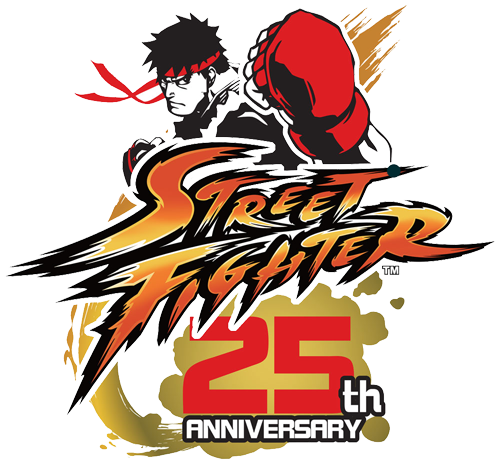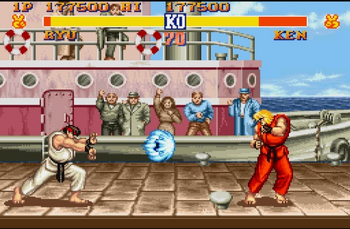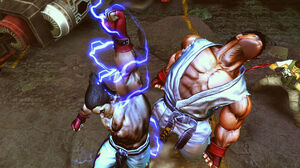Street Fighter is celebrating it's 25th anniversary of punches, kicks, combos, and KO's. The series is legendary for bringing the genre of fighting games to a wider audience, and teaching players a new kind of competition and focus. The series has several main installments, crossover games, along with releases in other media such as movies, animated series, and comics.The latest release in the series, Street Fighter X Tekken, is a fast and furious crossover between two of the largest franchies in fighting game history.
To commerate the series on it's special birthday, we interviewed Street Fighter X Teken producer Tomoaki Ayano about the style and history of the series, the magic of arcades, and the difficulty of designing and balancing a fighting game.
1. How difficult is it to keep each fighter’s strength and move set balanced against others in fights? What is the process you go through to make sure each character isn’t overpowered?
[Ayano] First, the team has to implement a work flow that allows for testing, change proposals, and then implementation. When we are putting together each fighter for the first time, it is very difficult to anticipate how their skills and move sets will interact with the rest of the roster, so we handle it as carefully as possible. Next, we perform rigorous play testing to see if our initial thoughts and expectations match the reality of the results or not. If we end up finding a move or tactic that seems to be too powerful when looking at the overall picture, we will devise multiple ways to address it and discuss which one is most suitable.
It’s important to be flexible during the entire process, as you can never really be sure how changes will end up affecting the entire gameplay ecosystem. Once we’ve decided on an agreeable fix, we will implement it, and then return to the testing stage again. In this way, we are constantly anticipating, testing, and fixing things throughout the process. There is a lot of trial and error involved, but as gameplay balance can be what makes or breaks a fighting game, we believe it is paramount to get it right.
2. How do you design a fighting game that is accessible to players with a wide variety of fighting-game experience? Does this change your priorities going into the design process?
[Ayano] Players with different levels of fighting game experience have different wants and needs as consumers. The tricky part is coming up with a game that is both unique and interesting to all sorts of users. There is a very delicate balance between coming up with a brand new complex battle system that can keep hardcore fans interested in the long term, and also in making the game accessible enough so that beginners don’t feel overwhelmed when they start playing. We spend a large portion of the development process trying to achieve that balance, so that our games can appeal to as many people as possible. Accessibility is definitely a very high priority from the very beginning of the design process.
3. How has the influence of other fighting games, new and modern, changed over the history of Street Fighter? Are there other games that inspire you in particular?
[Ayano] When developing a new title, we always try to keep an open mind, and get inspiration from popular culture at the time, regardless of genre. Action, Fighting, FPS, RPG, etc, we pay attention to whatever users find fun and interesting, and try to breakdown those elements so that they can be applied to our own titles as well. This doesn’t just apply to videogames either! I am constantly looking at all kinds other kinds of culture and entertainment as well, because you can never be exactly sure when that moment of inspiration might hit you.
4. Street Fighter IV had a distinct art style from the rest of the Street Fighter franchise. How has the response been from players and do you see similar artistic variety in the franchise's future?
[Ayano] With Street Fighter IV, we decided to use 3D polygons for the games graphics, but it was very important for us to keep the Street Fighter “flavor” that was so well loved from previous series. Thus, one of the design concepts for the style was “moving art.” Previous Street Fighter titles were done with pixel dot art, and in order to pay tribute to those past games, we tried to keep that same feeling with our concept of “moving art.” We believe that we were successful with utilizing modern day technology in order to bring our concepts to fruition, and the response from fans was very positive. It’s hard to say what kind of style future titles will hold, but we are always looking towards bringing fans the best experiences possible.
5. Street Fighter, along with many other fighting game series, tend to re-release different versions of the same game (ex. Street Fighter IV, Super Street Fighter IV, etc). Whether it’s an installment with more characters or tournament editions, what are the benefits to releasing different versions like this?
[Ayano] Doing major updates on a title allows the game to evolve in new ways. Whenever we release updated versions, we always try to do a number of things, be it adding new characters, rebalancing the gameplay, or even adding in new gameplay mechanics. Because of these revisions, the game is able to evolve to a brand new level, and the overall user experience improves as a result. Fans invest in and play our games for a long time, and we like to think of new versions as a way to provide those loyal fans with new content that they can continue to enjoy.
6. What is planned for the future of the Street Fighter series, other than the next main installment in the series, is there anything else new coming our way?
[Ayano] We wish to continue to provide a fighting game experience that cannot be matched by other companies and will continue to strive to innovate in the genre. Making fighting games one of the top online genres is a goal for us, so we want to focus not only on the normal game design, but also on the possible services that can accompany a product. We want as many people as possible to have a chance to experience “Street Fighter,” so we are looking towards expanding our title offerings on mobile and handheld devices. Street Fighter X Tekken is coming out for the iOS and PS VITA later this year, and we hope that all of the users out there will give them a try!
7. Arcades began strong, began to dwindle and close down, and are now resurging in popularity. Will you continue to develop arcade cabinets for new Street Fighter releases? How does it feel knowing new fighting games can still be experienced in the classic fighter way?
[Ayano] Personally, arcades mean a lot to me, as that was where I first encountered Street Fighter. Creating new titles that can be played in a public place like an arcade, where people can compete and communities can be formed, are very important. If possible, we would like to keep releasing new Street Fighter titles in the arcades and I hope every one of you will support your local arcade scene by making trips there frequently and joining in weekly competitions!
8. Crossover fighters, such as Marvel vs. Capcom, Street Fighter X Tekken, and Tatsunoko vs. Capcom have become very popular. Is there another fighting game series that you’d love to see square up against the Street Fighter cast?
[Ayano] As you are probably aware, Street Fighter has had so many crossovers already, it would actually be tough to find a new opponent! [laugh] For the time being, we are just focusing on Street Fighter X Tekken for the PS VITA which releases on October 23rd in North America. We have a lot of new content for the game such as crossplay functionality, near sharing, front and rear panel touch controls, gallery mode, AR capabilities, etc, just to name a few, so please check it out when the game launches!
9. How did the gameplay and feel of Street Fighter evolve with the new technological generation? Street Fighter II and Street Fighter IV play similarly but feel pretty different. What game elements did you focus on keeping from past installments? What game elements did you tweak or evolve for Street Fighter IV?
[Ayano] The Street Fighter series has evolved with every hardware generation. With the Super Nintendo, the 6 button arcade experience was able to be replicated. With the original PlayStation and the Sega Saturn, the graphics improved a great deal. With The PS2 and Dreamcast, online play was finally made a reality. So in this way, the series has always been making strides as the existing hardware also improved. With Street Fighter IV, we thought long and hard about what kind of game to make, and instead of focusing on a particular element of the battle system, we decided to “return to the roots” of the series and make a game that was easily accessible to established and new users alike. We wanted the game to give off a “nostalgic, yet fresh” feeling, and I believe we achieved this. That is why Street Fighter IV was such a success, and why we are enjoying a new fighting game boom to this day.











